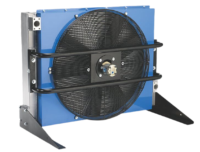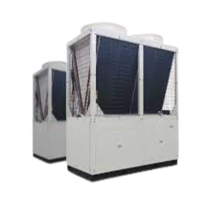An air- cooled chiller is a refrigeration system that uses air as the cooling medium to dissipate heat from the refrigerant. The introductory working principle of an air- cooled chiller involves the contraction, condensation, expansion, and evaporation of refrigerant to absorb and release heat. Also there’s a step- by- step explanation of the Air Cooled Chiller Working Principle.
Evaporator
- The process begins in the evaporator, where a low- pressure, low- temperature refrigerant absorbs heat from the process water or other fluid circulating through the chiller. As the refrigerant evaporates, it turns into a low- pressure vapor.
Compressor
- The low- pressure vapor is also compressed by the chiller’s compressor. Compression raises the temperature and pressure of the refrigerant, transubstantiating it into a high- pressure, high- temperaturegas.
Condenser
- The high- pressure, high- temperature refrigerant flows into the condenser, which is equipped with finned tubes or coils. In the air- cooled chiller, ambient air is drawn through the condenser coils by fans. The heat from the refrigerant is transferred to the air, causing the refrigerant to condense into a high- pressure liquid.
Expansion Valve
- The high- pressure liquid refrigerant passes through an expansion valve, where its pressure is swiftly reduced. This results in a drop in temperature and pressure, converting the refrigerant into a low- pressure, low- temperaturemixture.
Evaporator( Again)
- The low- pressure, low- temperature refrigerant returns to the evaporator, and the cycle repeats. It absorbs heat from the process water or fluid, continuing the nipping process.
In summary, the air cooled chiller working principle cycle involves the following pivotal steps
- Evaporation – Heat absorption in the evaporator causes the refrigerant to evaporate.
- Compression – The destroyed refrigerant is compressed, adding to its temperature and pressure.
- Condensation – Heat is expelled into the ambient air in the condenser, causing the refrigerant to condense into a liquid.
- Expansion – The high- pressure liquid passes through the expansion valve, reducing its pressure and temperature.
- Repeat – The cycle reprises as the low- pressure refrigerant returns to the evaporator to absorb farther heat.
Air- cooled chillers are constantly used in applications where water availability or quality is a concern. The effectiveness of these systems depends on factors similar as ambient air temperature and the overall design of the chiller unit


